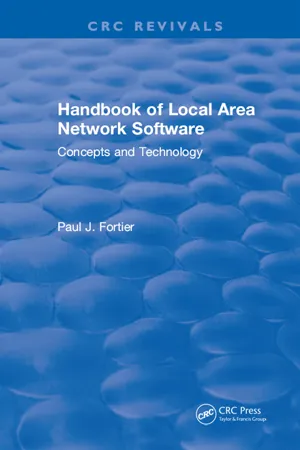Computer Science
Local Area Network
A Local Area Network (LAN) is a network that connects computers and devices within a limited area, such as a home, office, or school. It allows for the sharing of resources, such as files, printers, and internet connections, among connected devices. LANs are typically faster and more secure than wide area networks (WANs) due to their smaller geographic scope.
Written by Perlego with AI-assistance
6 Key excerpts on "Local Area Network"
Learn about this page
Index pages curate the most relevant extracts from our library of academic textbooks. They’ve been created using an in-house natural language model (NLM), each adding context and meaning to key research topics.
- eBook - ePub
CRC Handbook of Local Area Network Software
Concepts and Technology
- Paul L. Fortier(Author)
- 2018(Publication Date)
- CRC Press(Publisher)
1 INTRODUCTION TO Local Area NetworkSLocal Area Networks (LANs) continue to grow in popularity, as evidenced by the many new LAN products and the publicity related to them. Numerous classroom courses on the subject are offered as well as conferences and sessions dedicated to them. The draw is the promise of using LANs to interconnect various computers and resources into a unified system with more power and performance than is available from conventional nondistributed approaches.Potential users of Local Area Networks want to share information and programs, have increased computing power, or get at specified equipment. A LAN must provide services and interfaces compatible with a wide array of user requirements based on intended use. A LAN needs to be more than just a wire and connection mechanism. It must provide upper-level services to users that aid in their overall applications, design, development, and use—as do today’s operating systems. This class of service is the next great development opportunity. The lowest-level communications equipment and protocols are standardized and readily available off the shelf, but the upper-layer software is not so readily available. There is great opportunity for the company that can provide products for the upper-layer needs.How did we get where we are today? How did networks evolve? Basically, system designers have used four techniques to interconnect computer equipment. They are: 1. Centralized 2. Decentralized 3. Distributed 4. NetworkedFigure 1-1 Centralized Computer Interconnect.A centralized interconnect environment is a self-contained system capable of autonomous operation (Figure 1-1 ).A centralized interconnect exhibits a master/slave relationship between the CPU and the attached devices. The attached devices are typically strung off the I/O bus of the computer. Data is transferred in data blocks via direct address, using the centralized computer system’s operating system synchronization and timing mechanisms. It is engineered as a single, stand-alone entity where all devices are linked and controlled via the central processing subsystem. - eBook - ePub
Mechatronics
An Introduction
- Robert H. Bishop(Author)
- 2017(Publication Date)
- CRC Press(Publisher)
Figure 17.3 .Once a user is connected to a computer network, that user can communicate with any other user also connected to the network at some point. It is not required for a user to be connected directly to another user in order to communicate. In fact, in wide area networks, two communicating users will rarely be directly connected with each other. This implies that the users will be sharing the transmission links for exchanging their information. This is one of the most important aspects of computer networks. Sharing of resources improves utilization of the resources and is, of course, cost-effective as well. In addition to sharing the transmission links, the users will also share the processing power of the computers at the switching nodes, buffering capacity to store the information at the switching nodes, and any other resources that are connected to the computer network. A user who is connected to a computer network at any switching node will have immediate access to all the resources (databases, research articles, surveys, and much more) that are connected to the network as well. Of course, access to specific information may be restricted and a user may require appropriate authorization to access the information.The information from one user to another may need to pass through several switching nodes and transmission links before reaching its destination. This implies that a user may have many options available to select one out of many sequences of transmission links and switching nodes to exchange information. That adds to the reliability of the information exchange process. If one path is not available, not feasible, or not functional, some other path may be used. In addition, for better and effective sharing of resources among several users, it is not appropriate to let any user exchange a large quantity of information at a time; however, it is not uncommon that some users may have a large quantity of information to exchange. In that case, the information is broken into smaller units known as packets of information. Each packet is sent toward its destination as a separate entity and then all packets are assembled together at the destination side to re-create the original piece of information [2]. - eBook - ePub
- Jerry C. Whitaker(Author)
- 2018(Publication Date)
- CRC Press(Publisher)
• Internetworking: Also known as LAN-to-LAN networking or connectivity, internetworking involves the connection of multiple LANs and is very common in corporations in which users on departmental LANs now need to share data or otherwise communicate. The challenge of internetworking is in getting departmental LANs of different protocol stacks (as determined by use of the OSI model) to talk to each other, while only allowing authorized users access to the internetwork and other LANs. Variations of internetworking also deal with connecting LANs to mainframes or minicomputers rather than to other LANs.• Wide area networking: Also known as enterprise networking, involves the connection of computers, network nodes, or LANs over a sufficient distance as to require the purchase of wide area network (WAN) service from the phone company or alternative carrier. In some cases, the wide area portion of the network may be owned and operated by the corporation itself. Nonetheless, the geographic distance between nodes is the determining factor in categorizing a wide area network. A subset of WANs known as metropolitan area networks (MANs) are confined to a campus or metropolitan area of usually not more than a few miles in diameter.The important thing to remember is that categorization of networking is somewhat arbitrary and that what really matters is that the proper networking technology (hardware and software) is specified in any given networking opportunity in order to meet stated business objectives.22.2 Personal Remote Connectivity Applications The overall methodology for analysis and design of remote connectivity networking can be summarized as follows: 1. Needs analysis 2. Logical topology choice 3. Physical topology or architecture choice 4. Technology review and specification Remote Connectivity Needs AnalysisRemote connectivity needs analysis involves documenting the nature and extent of the use of local LAN resources by the remotely connected user. Choices of logical or physical topology for this remote LAN connectivity may be limited depending on the outcome of the remote connectivity needs analysis. Among the possible information sharing needs of remote users are the following: (1) exchange e-mail, (2) upload and download files, (3) run interactive application programs remotely, and (4) utilize LAN attached resources such as printers. One additional question will have a direct impact on topology choice: (5) How many remote users will require simultaneous access to local LAN attached resources? - eBook - ePub
Telecommunications
A Handbook for Educators
- Resa Azarmsa(Author)
- 2013(Publication Date)
- Routledge(Publisher)
gateway is used to connect them. The gateway translates the protocols in order to allow computers on the two networks to communicate. Gateways may also provide the translation between the media and electrical specifications of two-device network.Wide Area Network (WAN)The wide area network (WAN) systems are too separated, either physically or geographically, to be included in a small inhouse network. In other words WANs corner a much larger geographical area throughout than a LAN. They usually require the crossing of public rights of way, and use a common carrier (telephone company). A common carrier is a governmentregulated private company that furnishes the general public with communication facilities. The most noted examples of common carriers are AT&T, the Bell operating companies, US Sprint, MCI and so forth. WAN’s use a broad range of communication media for interconnection and can be located as close together as a few blocks or as far away as another country. They generally use transmission media, such as microwave or satellite transmission, but they are not limited to these two forms.Figure 5.5. Hybrid NetworkLocal Area Wireless NetworkMost LANs are formed with a blend of twisted part wires (telephone wire), fiber optic cable, and coaxial cable. Local Area Wireless Network is another form of network topology. The idea of wireless LAN comes from cellular mobile phones in which geographical areas are divided into hexagonally shaped cells, with adjacent cells having noninterfering radio frequencies. Forecasts for wireless LANs show 210 percent growth over the next three years (Clegg, 1991).There are three basic technologies used to transmit data without wire. These technologies include spread spectrum radio, narrow band radio, and infrared light - Healthcare Information & Management Systems Society (HIMSS)(Author)
- 2019(Publication Date)
- Productivity Press(Publisher)
LLab Results Interface: See LRI.Laboratory information management system: See LIS .Laboratory information system: See LIS .LAN (Learning and Action Network): The U.S. Department of Health and Human Services launched (through CMS) the Health Care Payment Learning and Action Network (LAN) in March 2015 to align with public and private sector stakeholders in shifting away from the current FFS, volume-based payment system to one that pays for high-quality care and improved health. The LAN provides a forum for generating evidence, sharing best practices, developing common approaches to the design and monitoring of APMs, and removing barriers to healthcare transformation across the U.S. healthcare system.26LAN (Local Area Network): A single network of physically interconnected computers that is localized within a small geographical area. Operates in a span of short distances (office, building, or complex of buildings).10 See MAN , WAN , and WLAN .LAN adapter: Allows access to a network, usually wireless network.202LASA (Look alike/Sound alike Drugs): Care providers developed a list of look-alike/sound-alike medications it stores, dispenses, or administers. LASA lists are used to determine which medications require special safeguards to reduce the risk of errors and minimize harm.229Large dialysis organization: See LDO.LAT (Local area transport): A proprietary network protocol developed by Digital Equipment Corp. and used in Local Area Networks and terminal server connections. LAT was created to provide connection between terminal servers and host computers via Ethernet cable, and enable communication between these hosts and serial devices such as video terminals andprinters.52- eBook - ePub
- Paul J. Fortier(Author)
- 2018(Publication Date)
- CRC Press(Publisher)
3 Modeling of Local Area NetworksThe previous chapters addressed modeling as one issue and Local Area Networks as another. This chapter brings them together to present a view of how modeling can aid in LAN selection, design, and research.Local Area Networks represent an important component of a user’s computer system resource. As was said earlier, it provides the means to interconnect and unify disjointed computing resources into a computer network. The selection of a LAN to best meet the needs of an end user is a critical component in the system selection process. Whether it is a completely new system or an integration of a network into existing equipment, the process of selecting a LAN is the same.The potential LAN purchaser must develop a set of requirements, perform some type of selection process (modeling, document review, analysis of existing implementations, or all of the above), select a LAN, install it, and then put it into use. The selection process typically requires a performance evaluation of the network versus some criteria such as speed, throughput, overhead, workload mix, number of nodes supported, etc. If proper performance evaluation and prediction is performed, the selection process should be much more fulfilling.Good performance evaluation and prediction must begin early in the product selection phase and the selection criteria must be developed and documented early in the process. That is, the applications to be performed and the expected workloads to be applied to it must be defined as must the services required of the prospective system (hardware, software, network). The applications refer to the type or class of the end user process (e.g., mail services, database services, remote operating, remote process execution, distributed computations, real time control, data processing, etc.), whereas the workload implies the volume or amount of service requirements placed on the system based on the applications.





